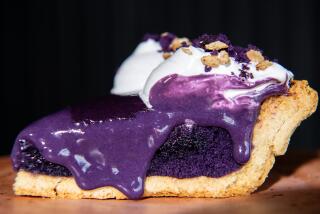The Size of Pies
- Share via
There are two main kinds of pie, the eat-’em-now kind and the store-’em-away kind. We make only the former today, but the American idea of pie is still colored by the large “standing” pie, a medieval European way of preserving food. It’s why we make plate-sized pies in a world in which the handful or even the mouthful is the usual pie size, and why small Asian pies such as samosas and dim sum don’t seem like pies to us; they tend to be called dumplings in English.
The standing pie, filled with meats and dried fruits (mince pie is its modern descendant), reflects the cold climate of northern Europe. It’s no accident that the Tatars, the northernmost Muslim nation, are known for baking large, rectangular meat pies called belish. But large pies used to be made in India and the Middle East--for royal hunting expeditions, often huge ones. A medieval traveler might take along a barmakiyya (named for a family of viziers to the caliphs of Baghdad), which was a large, rather flat, meat pie.
When you expand the definition of “pie” to include products for which the dough isn’t rolled out, you include pies (well, why not call them pies?) made from grains other than wheat, such as tamales and all the stuffed glutinous rice balls of eastern Asia.
And also the mujabbana. For this medieval Moorish snack, you’d punch a hole in a lump of leavened bread dough, stick in some cheese (mujabbana means filled with cheese) and pinch the hole closed before baking it. It tended to be puffy, and its cheeseless modern descendant is the Spanish almojavana, a sort of cruller.


